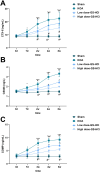Effects of Different Doses of Glucosamine Hydrochloride on Cartilage Tissue and Levels of Joint Injury Markers in Knee Osteoarthritis
- PMID: 40387631
- PMCID: PMC12087291
- DOI: 10.1111/jcmm.70579
Effects of Different Doses of Glucosamine Hydrochloride on Cartilage Tissue and Levels of Joint Injury Markers in Knee Osteoarthritis
Abstract
This study analysed the effects of different doses of glucosamine hydrochloride (GS-HCl) on cartilage tissue and the levels of joint injury markers in knee osteoarthritis (KOA). The Sham group, KOA group, low-dose GS-HCl group and high-dose GS-HCl group were established, with six mice in each group. The levels of joint injury markers (COMP, CS846 and CTX-II), inflammatory cytokines (IL-6, TNF-α and iNOS), oxidative stress indicators (MDA and SOD) and matrix remodelling proteins (MMP-3 and TIMP-1) were analysed. The degeneration of knee femoral condyles, histopathological changes and tissue apoptosis rate of the articular cartilage was also assessed. Mice in the KOA group displayed elevated COMP, CS846, CTX-II, IL-6, TNF-α, iNOS and MDA contents, reduced SOD activity, an irregular articular cartilage surface, a serious cartilage defect, a disordered articular cartilage surface in the defect, disappeared cartilage cells, obvious synovial cell proliferation and visible inflammatory cell infiltration. In the tissue, apoptosis rate and MMP-3 and TIMP-1 protein expression increased. Different doses of GS-HCl treatment could reduce COMP, CS846, CTX-II, IL-6, TNF-α, iNOS and MDA contents, apoptosis rate and MMP-3 and TIMP-1 protein expression, increase SOD activity and improve histopathological conditions in KOA mice. The improvement effects in each indicator in the high dose-GS-HCl group were more significant than those in the low dose-GS-HCl group. The intragastric administration of the GS-HCl group partially prevents the degeneration of articular cartilage in KOA mice. The mechanism may be to reduce inflammatory factors and oxidative stress indicator expression and matrix degradation, thereby delaying osteoarthritis progression.
Keywords: cartilage tissue; different doses; glucosamine hydrochloride; joint injury; knee osteoarthritis; markers.
© 2025 The Author(s). Journal of Cellular and Molecular Medicine published by Foundation for Cellular and Molecular Medicine and John Wiley & Sons Ltd.
Conflict of interest statement
The authors declare no conflicts of interest.
Figures






Similar articles
-
Repairing effects of glucosamine sulfate in combination with etoricoxib on articular cartilages of patients with knee osteoarthritis.J Orthop Surg Res. 2020 Apr 16;15(1):150. doi: 10.1186/s13018-020-01648-z. J Orthop Surg Res. 2020. PMID: 32299482 Free PMC article.
-
Yiqi Yangxue formula inhibits cartilage degeneration in knee osteoarthritis by regulating LncRNA-UFC1/miR-34a/MMP-13 axis.J Ethnopharmacol. 2025 Jan 30;337(Pt 3):118930. doi: 10.1016/j.jep.2024.118930. Epub 2024 Oct 10. J Ethnopharmacol. 2025. PMID: 39393561
-
Expression level of proteoglycan, collagen and type II collagen in osteoarthritis rat model is promoted and degradation of cartilage is prevented by glucosamine methyl ester.Eur Rev Med Pharmacol Sci. 2018 Jun;22(11):3609-3616. doi: 10.26355/eurrev_201806_15188. Eur Rev Med Pharmacol Sci. 2018. PMID: 29917216
-
Factors related to degradation of articular cartilage in osteoarthritis: a review.Semin Arthritis Rheum. 1998 Jun;27(6):392-9. doi: 10.1016/s0049-0172(98)80019-x. Semin Arthritis Rheum. 1998. PMID: 9662758 Review.
-
The role of cytokines in osteoarthritis pathophysiology.Biorheology. 2002;39(1-2):237-46. Biorheology. 2002. PMID: 12082286 Review.
References
-
- Gelber A. C., “Knee Osteoarthritis,” Annals of Internal Medicine 177, no. 9 (2024): ITC129. - PubMed
-
- Dalili D., Holzwanger D. J., Fleming J. W., et al., “Advanced Interventional Procedures for Knee Osteoarthritis: What Is the Current Evidence?,” Seminars in Musculoskeletal Radiology 28, no. 3 (2024): 267–281. - PubMed
-
- Karaborklu Argut S., Celik D., Ergin O. N., and Kilicoglu O. I., “Does the Combination of Platelet‐Rich Plasma and Supervised Exercise Yield Better Pain Relief and Enhanced Function in Knee Osteoarthritis? A Randomized Controlled Trial,” Clinical Orthopaedics and Related Research 482, no. 6 (2024): 1051–1061. - PMC - PubMed
MeSH terms
Substances
LinkOut - more resources
Full Text Sources
Research Materials
Miscellaneous

